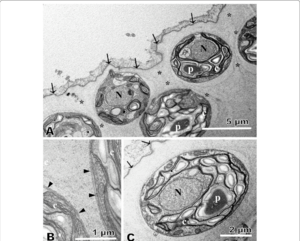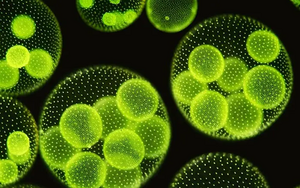Volvox africanus: Difference between revisions
No edit summary |
No edit summary |
||
| (62 intermediate revisions by the same user not shown) | |||
| Line 1: | Line 1: | ||
[[File:Volvox_image.jpg|thumb|Volvox africanus sample under a microscope at 400X magnification. Image credit: The University of Texas at Austin. https://utex.org/products/utex-lb-1890]] | [[File:Volvox_image.jpg|thumb|''Volvox africanus'' sample under a microscope at 400X magnification. Image credit: The University of Texas at Austin. https://utex.org/products/utex-lb-1890]] | ||
[[File:Volvox_image_2.png|thumb|Volvox africanus samples under a transmission electron microscope. The samples are in the asexual spheroid form. Image credit: Nozaki, Mahakham, Heman, Matsuzaki, and Kawachi (2022). https://www.researchgate.net/publication/358009972_Morphology_mating_system_and_taxonomy_of_Volvox_africanus_Volvocaceae_Chlorophyceae_from_Thailand]] | [[File:Volvox_image_2.png|thumb|''Volvox africanus'' samples under a transmission electron microscope. The samples are in the asexual spheroid form. Image credit: Nozaki, Mahakham, Heman, Matsuzaki, and Kawachi (2022). https://www.researchgate.net/publication/358009972_Morphology_mating_system_and_taxonomy_of_Volvox_africanus_Volvocaceae_Chlorophyceae_from_Thailand]] | ||
[[File:Volvox_image_3.webp|thumb|Computer animated reconstruction of a | [[File:Volvox_image_3.webp|thumb|Computer animated reconstruction of a ''Volvox''. Image credit: https://botnam.com/volvox-case-study-guide/]] | ||
== Classification == | == Classification == | ||
| Line 17: | Line 17: | ||
== Description and Significance == | == Description and Significance == | ||
''Volvox africanus'' is a photosynthetic, multicellular eukaryotic microbe that lives in clusters. ''Volvox'' species exist as many cell colonies within a gelatinous barrier. They contain anywhere from several hundred to 6,000 cells within their gelatin bubble. In fact, the largest clusters are barely visible with the naked eye. | |||
Volvox | ''Volvox'' is a freshwater algal genus that was first discovered by Anton von Leeuwenhook in the 1700s. They have fascinating reproductive cycles consisting of both sexual and asexual reproduction. | ||
== Genome Structure == | |||
== | ''Volvox africanus'' has a haploid, linear genome, with between 129-142 megabases (mb). The National Center for Biotechnology Information (NCBI) holds two full genomic sequences of this species. One sequence discovered about 13,455 protein coding genes, 129 contigs, and that 53% of the genome is comprised of GC nucleotides. The other sequence resulted in different data. It matched the first with the genome containing 53% of GC nucleotides, however, it found 12,742 protein coding genes and 448 contigs. | ||
== Cell Structure, Metabolism, and Life Cycle == | |||
''Volvox africanus'' shape is complex to describe due to the vast number of cells within their gelatinous barrier. Essentially, one ''Volvox'' is a bunch of cocci unicellular organisms living within a spheritical gel-like substance. Each of cocci cells, either somatic or germ cells, have two flagella. Other organelles include; chloroplasts, eyespots, and vacuoles. The somatic cells move their flagellum in tandem for fast, coordinated directional movements. Their eyespot further compliments this because it directs the somatic cell's flagellar movements to the location of light. As a result, the ''Volvox'' chloroplasts receive a plethora of photosynthesis opportunities. This is critical as photosynthesis is the primary energy source of the ''Volvox''. | |||
Germ cell reproduction is complex and unique because it utilizes both asexual and sexual reproduction. ''Volvox africanus'' reproduction is classified as homothallic with differentiated male and female germ cells. Essentially, this means somatic cells can asexually reproduce, but the clusters also contain male and female germ cells or spheroids that can sexually reproduce. Multiple rounds of somatic cell asexual reproduction occurs between sexual reproduction stages. | |||
== | == Ecology and Pathogenesis == | ||
''Volvox africanus'' is typically found in South Africa, south Asia, and other southern african countries. Like many algal species, ''Volvox'' live in freshwater sources and rely on photosynthesis for nutrients and energy. As a result, they are valuable for consuming carbon dioxide and releasing oxygen for aerobic organisms. Each somatic cell contains one chloroplast. | |||
Volvox | All discovered ''Volvox'' species are non-pathogenic. It is unlikely that there undiscovered pathogenic ''Volvox'' species or that a current species will evolve into a pathogen without the removal of chloroplast and photosynthetic metabolism genes. It would be very energetic costly and trivial to undergo photosynthesis and derive another organism of nutrients. | ||
== References == | |||
= | Algae Base. (2023) ''Volvox africanus'' G.S.West 1910. https://www.algaebase.org/search/species/detail/?species_id=C60a996d47989b5be | ||
Britannica. (2018) ''Volvox''. https://www.britannica.com/science/Volvox | |||
Nozaki H, Mahakham W, Heman W, Matsuzaki R, Masanobu K. (2022) Morphology, mating system and taxonomy of Volvox africanus (Volvocaceae, Chlorophyceae) from Thailand. (2022) Botanical Studies 63. https://doi.org/10.1186/s40529-022-00332-1 | |||
Nozaki H, Matsuzaki R, Yamamoto K, Kawachi M, Takahashi F. (2015) Delineating a New Heterothallic Species of Volvox (Volvocaceae, Chlorophyceae) Using New Strains of "Volvox africanus". PLOS One 10. https://doi.org/10.1371/journal.pone.0142632 | |||
= | Schoch CL, et al. NCBI Taxonomy: a comprehensive update on curation, resources and tools. Database (Oxford). 2020: baaa062. PubMed: 32761142 PMC: PMC7408187. https://www.ncbi.nlm.nih.gov/Taxonomy/Browser/wwwtax.cgi?id=51714 | ||
Yamamoto K, Kawai-Toyooka H, Hamaji T, Tsuchikane Y, Mori T, Takahashi F, Sekimoto H, Ferris PJ, Nozaki, H. (2017) Molecular evolutionary analysis of a gender-limited MID ortholog from the homothallic species ''Volvox africanus'' with male and monoecious spheroids. PLOS One 12. https://doi.org/10.1371/journal.pone.0180313 | |||
https:// | |||
== Authors == | == Authors == | ||
Page authored by Hayden Hull, student of Professor Bradley Tolar at UNC Wilmington. | |||
[[Category:Pages edited by students of Bradley Tolar at UNC Wilmington]] | [[Category:Pages edited by students of Bradley Tolar at UNC Wilmington]] | ||
Latest revision as of 04:39, 12 December 2023



Classification
Eukarya; Chlorophyta; Chlorophyceae; Chlamydomonadales; Volvocaceae
Species
Volvox africanus
NCBI: [1]
Description and Significance
Volvox africanus is a photosynthetic, multicellular eukaryotic microbe that lives in clusters. Volvox species exist as many cell colonies within a gelatinous barrier. They contain anywhere from several hundred to 6,000 cells within their gelatin bubble. In fact, the largest clusters are barely visible with the naked eye.
Volvox is a freshwater algal genus that was first discovered by Anton von Leeuwenhook in the 1700s. They have fascinating reproductive cycles consisting of both sexual and asexual reproduction.
Genome Structure
Volvox africanus has a haploid, linear genome, with between 129-142 megabases (mb). The National Center for Biotechnology Information (NCBI) holds two full genomic sequences of this species. One sequence discovered about 13,455 protein coding genes, 129 contigs, and that 53% of the genome is comprised of GC nucleotides. The other sequence resulted in different data. It matched the first with the genome containing 53% of GC nucleotides, however, it found 12,742 protein coding genes and 448 contigs.
Cell Structure, Metabolism, and Life Cycle
Volvox africanus shape is complex to describe due to the vast number of cells within their gelatinous barrier. Essentially, one Volvox is a bunch of cocci unicellular organisms living within a spheritical gel-like substance. Each of cocci cells, either somatic or germ cells, have two flagella. Other organelles include; chloroplasts, eyespots, and vacuoles. The somatic cells move their flagellum in tandem for fast, coordinated directional movements. Their eyespot further compliments this because it directs the somatic cell's flagellar movements to the location of light. As a result, the Volvox chloroplasts receive a plethora of photosynthesis opportunities. This is critical as photosynthesis is the primary energy source of the Volvox.
Germ cell reproduction is complex and unique because it utilizes both asexual and sexual reproduction. Volvox africanus reproduction is classified as homothallic with differentiated male and female germ cells. Essentially, this means somatic cells can asexually reproduce, but the clusters also contain male and female germ cells or spheroids that can sexually reproduce. Multiple rounds of somatic cell asexual reproduction occurs between sexual reproduction stages.
Ecology and Pathogenesis
Volvox africanus is typically found in South Africa, south Asia, and other southern african countries. Like many algal species, Volvox live in freshwater sources and rely on photosynthesis for nutrients and energy. As a result, they are valuable for consuming carbon dioxide and releasing oxygen for aerobic organisms. Each somatic cell contains one chloroplast.
All discovered Volvox species are non-pathogenic. It is unlikely that there undiscovered pathogenic Volvox species or that a current species will evolve into a pathogen without the removal of chloroplast and photosynthetic metabolism genes. It would be very energetic costly and trivial to undergo photosynthesis and derive another organism of nutrients.
References
Algae Base. (2023) Volvox africanus G.S.West 1910. https://www.algaebase.org/search/species/detail/?species_id=C60a996d47989b5be
Britannica. (2018) Volvox. https://www.britannica.com/science/Volvox
Nozaki H, Mahakham W, Heman W, Matsuzaki R, Masanobu K. (2022) Morphology, mating system and taxonomy of Volvox africanus (Volvocaceae, Chlorophyceae) from Thailand. (2022) Botanical Studies 63. https://doi.org/10.1186/s40529-022-00332-1
Nozaki H, Matsuzaki R, Yamamoto K, Kawachi M, Takahashi F. (2015) Delineating a New Heterothallic Species of Volvox (Volvocaceae, Chlorophyceae) Using New Strains of "Volvox africanus". PLOS One 10. https://doi.org/10.1371/journal.pone.0142632
Schoch CL, et al. NCBI Taxonomy: a comprehensive update on curation, resources and tools. Database (Oxford). 2020: baaa062. PubMed: 32761142 PMC: PMC7408187. https://www.ncbi.nlm.nih.gov/Taxonomy/Browser/wwwtax.cgi?id=51714
Yamamoto K, Kawai-Toyooka H, Hamaji T, Tsuchikane Y, Mori T, Takahashi F, Sekimoto H, Ferris PJ, Nozaki, H. (2017) Molecular evolutionary analysis of a gender-limited MID ortholog from the homothallic species Volvox africanus with male and monoecious spheroids. PLOS One 12. https://doi.org/10.1371/journal.pone.0180313
Authors
Page authored by Hayden Hull, student of Professor Bradley Tolar at UNC Wilmington.
